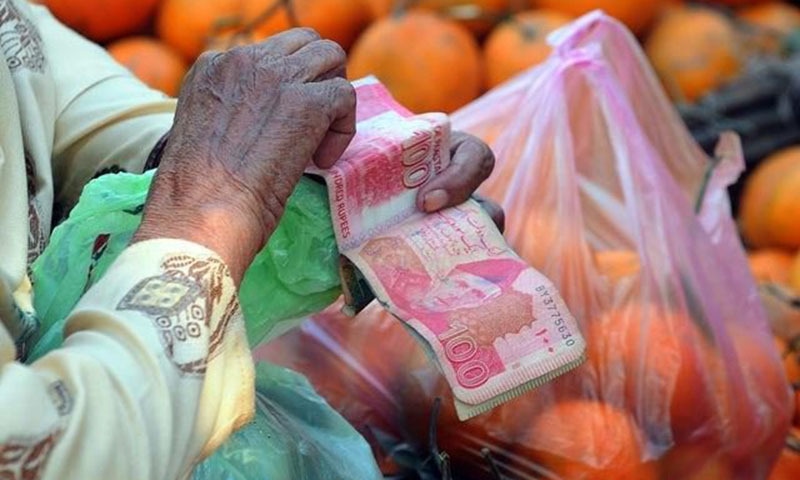By Staff Reporter
ISLAMABAD: The headline inflation is expected to remain within a modest 1-1.5 percent range in March 2025, the Finance Division said on Tuesday, offering a cautiously optimistic outlook amid improving fiscal and external account metrics.
However, the ministry warned that inflation could edge up to 2-3 percent in April, driven by potential volatility in food and energy prices, underscoring the fragility of the country’s economic recovery.
In its latest Monthly Economic Update and Outlook, the Finance Division highlighted a mix of resilience and vulnerability across key economic indicators.
“Inflation is anticipated to remain within the range of 1.0-1.5 percent for March 2025 and inching up to 2-3 percent in April 2025,” the report stated, linking the recent decline in inflation to falling food and energy costs. Yet, it cautioned that these drivers remain unpredictable, posing risks to the downward trend.
Pakistan’s inflation has been a rollercoaster in recent years, peaking at a record 38 percent in May 2023 before embarking on a steady decline. Data from the Pakistan Bureau of Statistics (PBS) showed headline inflation at 1.5 percent year-on-year in February 2025, down from 2.4 percent in January, reflecting softer prices for perishable food items (down 20.3 percent), non-perishable food items (down 1.5 percent), transport (down 1.1 percent), and housing, water, electricity, gas, and fuels (down 0.6 percent).
However, upward pressure persisted in sectors like health (up 14.3 percent), clothing and footwear (up 13.8 percent), and education (up 10.9 percent).
The Monetary Policy Committee (MPC) of the State Bank of Pakistan, in its last meeting held earlier this month, opted to keep the policy rate steady at 12 percent. The committee noted that inflation in February 2025 turned out lower than expected, mainly due to a drop in food and energy prices, but it warned that “notwithstanding this decline, the committee assessed the risks posed by the inherent volatility in these prices to the current declining trend in inflation. At the same time, core inflation is proving to be more persistent at an elevated level and thus uptick in the food and energy prices may lead to an increase in inflation”.
On the fiscal front, the government’s efforts to tighten spending and boost revenue appear to be paying off. “Fiscal consolidation measures are yielding tangible results, leading to a primary surplus and a narrowed fiscal deficit,” the Finance Division reported. The fiscal deficit shrank to 1.7 percent of GDP in the July-January period of fiscal year 2025 (FY25), down from 2.6 percent in the same period last year, signaling improved budgetary discipline amid ongoing economic reforms.
The external account position has shown remarkable improvement, buoyed by a sharp rise in workers’ remittances and a narrowing current account deficit (CAD). The CAD plummeted to $12 million in February from $420 million in the prior month. For the first eight months of FY25, the country posted a current account surplus of $691 million, a stark reversal from the $1.7 billion deficit recorded a year earlier.
The Finance Division credited this turnaround to a 32.5 percent surge in remittances, which hit $24 billion during July-February FY25, up from $18.1 billion the previous year. “In the coming months, remittances are likely to increase further due to the seasonal factors of Ramzan and Eids,” the report noted, with Saudi Arabia (24.6 percent) and the UAE (20.3 percent) leading as top sources.
Analysts have pointed to the Ramadan effect as a key stabilizer of the exchange rate, helping to bolster foreign exchange reserves, which currently stand at $11 billion—still short of the $13 billion target for FY25’s end.
Foreign direct investment (FDI) also surged by 41 percent to $1,618.4 million, with China contributing the largest share at $661.8 million (40.9 percent), followed by the UK (10.3 percent) and Hong Kong (9.9 percent).
The power sector attracted $578.2 million (35.7 percent), while financial business and oil and gas exploration drew $466.4 million (28.8 percent) and $196.6 million (12.1 percent), respectively.
Trade activity reflected growing economic momentum as goods exports rose 7.2 percent to $21.8 billion during July-February FY25, while imports climbed 11.4 percent to $38.3 billion. “Exports and imports are expected to improve owing to the expansion in economic activity,” the report said, noting that key markets like the UK, US, Europe, and China remain robust.
The factory output offered a mixed picture. “The recent month-on-month (MoM) growth in Large Scale Manufacturing (LSM) signals resilience, while the year-on-year (YoY) decline highlights underlying weaknesses that may continue to weigh on industrial performance,” the Finance Division observed. However, it pointed to “high-frequency indicators—such as positive growth in cement sales, increased automobile production, and higher imports—along with an easy monetary policy” as potential drivers of a production uptick, provided demand holds steady.
Favorable weather conditions were also cited as a boon for agriculture, a critical input for industrial output. “Favourable weather remains a key factor in ensuring better harvests contributing to meeting production targets,” the report added.
The Finance Division painted a cautiously optimistic picture, forecasting that exports, imports, and remittances will maintain their upward trajectory, keeping the current account “within manageable limits.” Yet, challenges persist. The central bank’s foreign exchange reserves, languishing at $11 billion, underscore the need for sustained inflows and investment to meet the $13 billion goal.
Copyright © 2021 Independent Pakistan | All rights reserved




